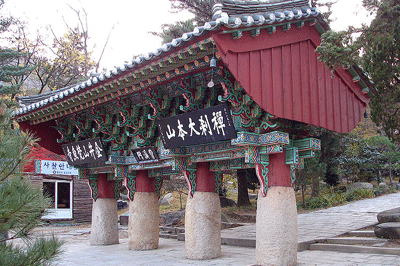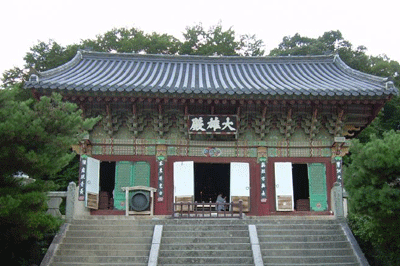Beomeo Temple (Temple of the Nirvana Fish) is a head temple of the Jogye Order of Korean Buddhism in Cheongnyong-dong, Geumjeong-gu, Busan, South Korea. Built on the slopes of Geumjeongsan, it is one of the country’s leading urban temples.
Beomeosa was constructed in 678 during the reign of Silla king Munmu, by the monk Uisang. It became known as one of the ten great temples of the Hwaeom sect, although like most Korean temples it was later assimilated into the Jogye Order. At its largest, during the Goryeo dynasty, it was much larger than it is today – with over 360 rooms and more than a thousand monks in residence. The temple was burned to the ground in 1592 during the Japanese invasion. It was reconstructed in 1602, but was burned again by an accidental fire. In 1613 it was rebuilt again. The main hall (Daeungjeon) and the front gate (Iljumun) date to this reconstruction.
The mountain where Beomeosa is found is said to have huge rock at the summit where there is a golden well which never, ever dries up. The water of this well is believed to have very special magical properties as one day a golden fish came from heaven and has lived there ever since.
One Pillar Gate
The One Pillar Gate is the first door that leads to the temple and represents the boundary between the secular world and the spiritual world where a visitor has to leave your complicated ideas and sufferings.. It is named as One Pillar Gate as the pillars are built in a row to support the roof, but generally two pillars are built side by side to support the roof on top. However, at the Beomeosa Temple, exceptionally four pillars support the roof with three kans in the front.
Daewoong
Daewoong is the virtuous name of Buddha and Daewoongjeon means the house of enshrining the Sakyamuni Buddha, Daewoong of heaven and earth. Daewoongjeon displayed the formative characteristics of simple and powerful construction space, typical of mid-Joseon with the dual roof shape. In particular, the canopy of Daewoongjeon is paired with the Sumidan(altar) to display the essence of the wooden craft works of Joseon Dynasty. The Sumidan is a Buddihist altar that is placed in one notch higher stage to enshrine Buddha. It has the shape of Mt. Sumi, located in the center of
universe, that the name was referred to as Sumidan.
In general, Daewoongjeon usually enshrine the historically presented person, Sakyamuni Buddha, but depending on each temple, it may differ in some degree. Sakyamuni Buddha learned the truth of universe and taught people where live comes from and where it goes, what human and life are, and how people live the life to be happy. “Daewoong” comes from the ancient word of India, ‘Mahabira,’ and it is an honorific term for Buddha, meaning great hero.
Phone: 051-508-5726
EMail: beomeosa@hanmail.com
Website: http://www.beomeo.kr







Comments are closed.